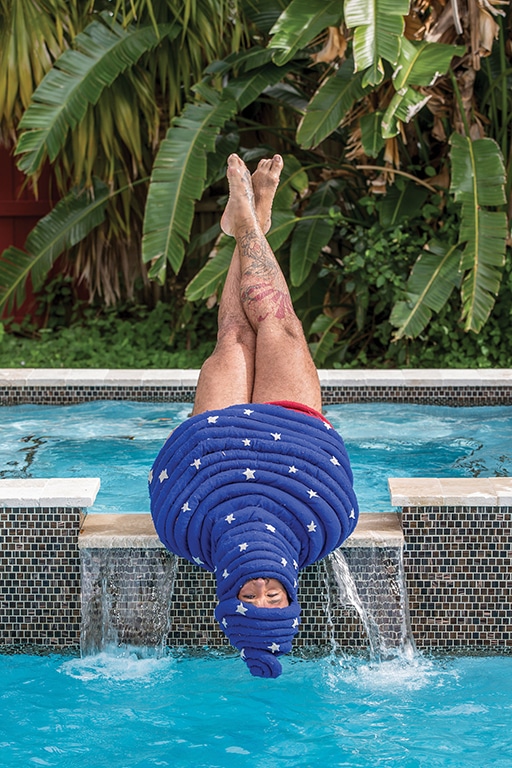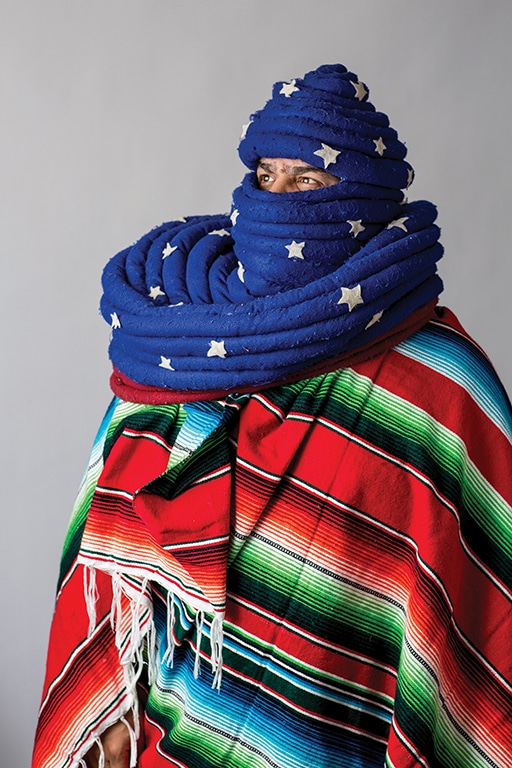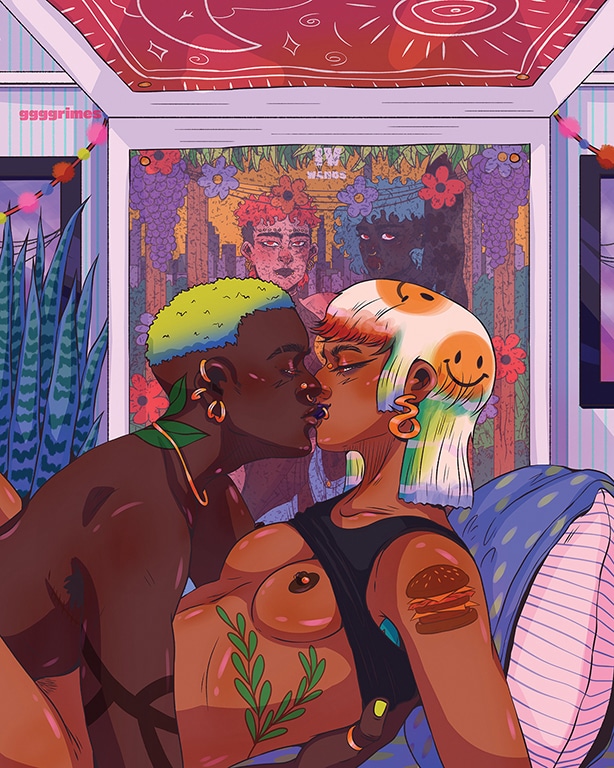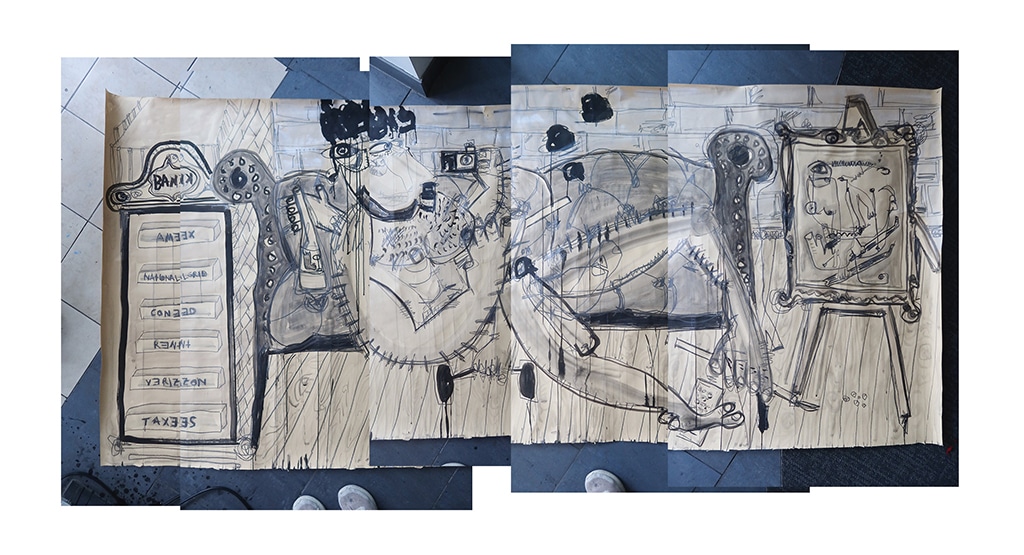UNTITLED: Being Irresponsible (India ink, graphite, acrylic) by Victor Jefferys II
by G.W. Mercure
Izzy Berdan is a photographer, creative consultant, provocateur, and self-described decolonizer.
So, what is a decolonizer? It isn’t something tangible or terrestrial. For Berdan, being a decolonizer is about decolonizing the mind and spirit, clearing those temples of the long, long influence of white, straight centralization, reversing the marginalization of BIPOC, queer, and non-white thought. The good history, and the other history.
“I had a very specific diagram of what I was supposed to be, visually, emotionally, and of what the American dream was, and the struggle that I always had to see myself in it. And so the idea of living my life as a decolonizer is about trying to imagine all of the choices that I make through a lens that is specific to me, and trying to be as true to myself as possible. So it’s about trying to remove the influence of everything that’s been done before me, and trying to intentionally think of how I move forward,” Berdan says.
BIPOC is a perplexing term in a way. Most of the world’s population is of color; it’s the default, so one might ask, isn’t it the Europeans who are outliers, the ones who should be identified with special terms? But the term holds particular meaning in the U.S., where the reality doesn’t yet support the true justice of the numbers and, in practice, the term is used to achieve and maintain solidarity among communities that have been locked out of mainstream culture (and justice) for so long that someday, when there’s only one white person left on Earth, those communities may still feel like they’re on the inside looking out. In that regard, the term serves. And in that way, the concept resonates with the lifework and vision that Izzy Berdan will bring to Juneteenth celebrations in Provincetown this month, specifically, Power, Joy, & Resilience, a BIPOC and queer art show hosted by The Commons on view now through June 22.


The show, curated by Berdan, will feature their provocative photographic statement on the angst and defiance of underserved Americans during the Muslim ban in the early days of the first (ugh) Trump Administration.
“It’s called Amurqa, and it is a portmanteau of America and burqa,” Berdan explains. “The garment modeled in the photographs is kind of like a structural art piece in that it’s a burqa of the American flag, and it’s from a very talented artist (Maxine Hwang Blomberg) that I’ve known and loved and worked with for a while. It captivated me and started me thinking about the juxtaposition of emotions that you have when you see an American flag, with the stars and stripes, as well as the visual of a burqa.”
Berdan was born in South Texas in 1978 to a family that, by today’s standards, could be called traditional. They believed in service and sacrifice, were rooted in religion, community, and the land, and those things were the greatest influence on Berdan’s early perception of the world.
Berdan moved to Boston in 1996, and their journey through art and activism, altruism and atavism, shifted gears, became restless, and became fruitful, personally and creatively. Their description of their creative life says it all with its haphazard mosaic of nouns and experiences, the tenses varying, hurried and imperfect, like life: “…Interior design, night clubs, sobriety, fashion, rugby, magazines, performing, hospitality, assault survivor, love and art.”
“It was fun,” Berdan recalls. “I’m happy I survived my crazy first couple of years, moving up to a city from a small, little hick town and and then when I got sober, it was life changing just having the capacity to remember and communicate clearly.”
In addition to Berdan, the show at The Commons will feature work by Serge Gay, Jr., Theodoor Grimes, Victor Jeffreys, LaNia Sproles, and Derrick Woods-Morrow. As Berdan rattles with great enthusiasm through descriptions of the other artists’ work and his warm connections with them, it starts to sound like a movement.

Gay, Jr., Berdan says, “does these massive, stunning murals and graffiti and public art pieces;” Grimes’ work “focuses a lot on trans men of color and…heavy on sexuality and sensuality mixed with like these brilliant, bright, beautiful colors;” Jeffreys “does everything from choreography to painting and photography…”
Berdan’s enthusiasm for the work evokes other shared movements, Jackson Pollock and Willem de Kooning at the Cedar Bar, hip-hop artists eagerly joining each other’s tracks. But here the work is a great deal more diverse: In praxis, what Berdan describes is maybe not an exchange of strictly artistic ideas, but more like something else: an exchange of cultural ideas? An exchange of revolutionary ideas? I guess you would call an exchange of revolutionary ideas something else. Maybe “history”?
Berdan recalls that they had some reckoning to do with the real history, the good history of their people (Berdan’s family is Mexican and Puerto Rican, originally). “In my lack of knowledge, I felt complicit in letting it happen, even though it happened before me. And I had to find somewhere to put all this energy and anger and frustration. How do I use this positively? How do I use all these feelings, and where do I start to try to self-correct and move my attention to things that I think will help me, my community, our society, towards some future where there’s an understanding of truth?”
Perhaps through reeconstructing the good history, like Juneteenth itself. And the only way to learn about good history, like good trouble, is to experience it.
Power, Joy, & Resilience is on view at The Commons, 46 Bradford St. now through June 22, with a special reception on Friday, June 20, 5-8 p.m. The event is free. For more information visit juneteenthptown.com/art-show.











